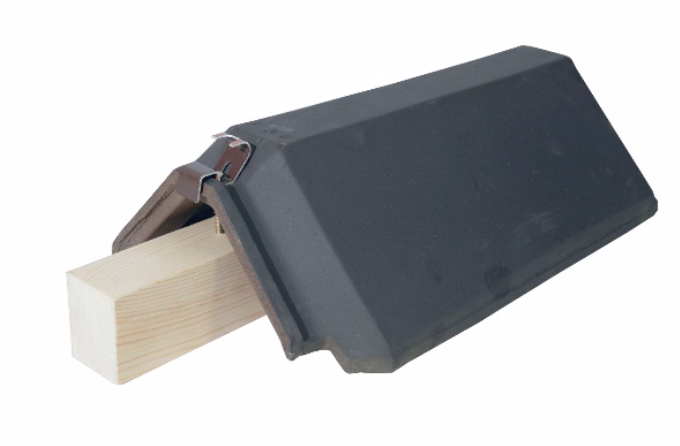Installing Edilians Imerys Roof Tiles in Compliance With BS 5534 Standards

Installing roof tiles in compliance with BS 5534
When BS 5534: 2014, The British Standard Code of practice for slating and tiling, was published, it represented a major revision of a Standard that was first published in 1978. Not only was it completely restructured to make the Standard easy to use, it also introduced many new changes to recognise up-to-date building principles and knowledge, such as wind loads on roof tiles and underlays and, perhaps most importantly of all, minimum fixing requirements were revised. I am sure that, by now, the industry is familiar with the concept of mechanically fixing all tiles and that mortar bedded components can no longer rely solely on the mortar for their resistance to wind uplift.
What does all this mean in practice? Firstly, a quick recap of the BS 5534 recommendations: -
Single Lap Tiles
For single lap tiles on all roof areas and rafter pitches, every tile should be mechanically fixed. More specifically, for rafter pitches of 450 and over, each tile should be nailed with at least one nail. For rafter pitches of 550 and over, including vertical tiling to walls, all tiles should be nailed and the tail of each tile should be clipped or otherwise mechanically fixed.
Double Lap Tiles
For nibless double lap plain tiles, two nails should be used to secure every tile. For nibbed double lap tiles, two nails should be used in each tile in at least every fifth course on rafter pitches below 600. For rafter pitches of 600 and above, including vertical tiling to walls, two nails should be used in every tile.
Perimeter Tiles
Perimeter tiles should be secured using a minimum of two fixings, one of which can be a clip, adhesive or dry verge capping system where appropriate. To avoid the use of small pieces of cut tiles that are difficult to fix, double tiles or tile-and-a-half tiles should be used where available from the manufacturer. Small pieces (less than half the tile width) of cut single lap tiles can be bonded or mechanically fixed to the adjoining full-width tile.
Minimum Fixings
I mentioned above that these are ‘minimum’ fixings and this is very important to understand; all roof tile installations require a wind load calculation to be carried out to establish if a) the minimum fixings are adequate and, b) to establish what additional fixings are required to resist predicted wind loads for the particular building and location.
Head nailing is very effective for preventing tiles from lifting off the batten during high winds and tail clipping is very effective at preventing the tails from lifting. Tiles that are head nailed and tail clipped are therefore extremely resistant to wind uplift. The new Edilians Double Panne S tile clip is a great example of a tail clip working in conjunction with a head nail to prevent the tile lifting off the batten, lifting at the tail or even rotating about a 45-degree axis; in other words, an extremely strong and efficient fixing system.
Use of Adhesive
It is interesting that adhesive technology has now advanced sufficiently to give our industry enough confidence to sanction the use of suitable adhesives to secure roof components; though of course, I must emphasise ‘suitable’ adhesive. Roof tile manufacturers can provide information on suitable adhesives for use with their tiles. I should also point out that the roofer is responsible for ensuring adhesive is used in accordance with its manufacturer’s recommendations and in suitable conditions. Care must be taken to ensure that adhesive does not block roof tile water channels or inhibit the flow of water, which could otherwise result in roof leaks. Adhesive should not be used as a substitute for the mechanical fixings described above nor should it be used to try to waterproof incorrectly constructed junctions or laps.
Ridge and Hip Tiles
All ridge and hip tiles must now be mechanically fixed, they can still be mortar-bedded, but there must be a mechanical connection to the structure; eg nail, screw or clip. Of course, for many roofs, the better way to install ridge and hip tiles is to use a dry fix system. These provide the necessary mechanical fixing and resistance to wind uplift and do not suffer from the maintenance issues that mortar does.
The Edilians 710 clay interlocking angle ridge is a great example of a ridge and hip tile that can be very simply, but very effectively, mechanically fixed using a clip and screw within the interlock – see illustration.
Dry Verge as Perimeter Tile Fixings
Many plastic dry verge manufacturers now design their systems with the mechanical fixing of the perimeter tiles in mind, rather than the units being a simple verge capping system. Where the dry verge is being relied upon as one of the two required tile fixings, ensure that the chosen system complies with BS 8612: the British Standard for dry fixed ridge, hip and verge systems.
Alternatively, use the tile manufacturer’s cloaked verge systems – Edilians has purpose-made integrated cloak verge tiles for many of its roof tiles.
Summary
Be mindful of the minimum fixing requirements for general tiling, perimeter tiles and ridge and hip tiles and always obtain a calculated fixing specification from the tile manufacturer.
View our Edilians range here: https://www.burtonroofing.co.uk/catalogsearch/result/?q=edilians

John Mercer: Technical Consultant to Edilians
November 2019
